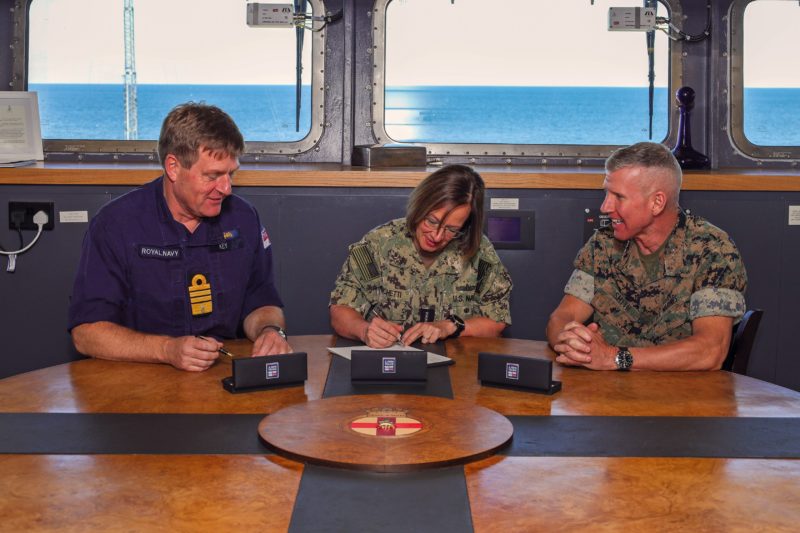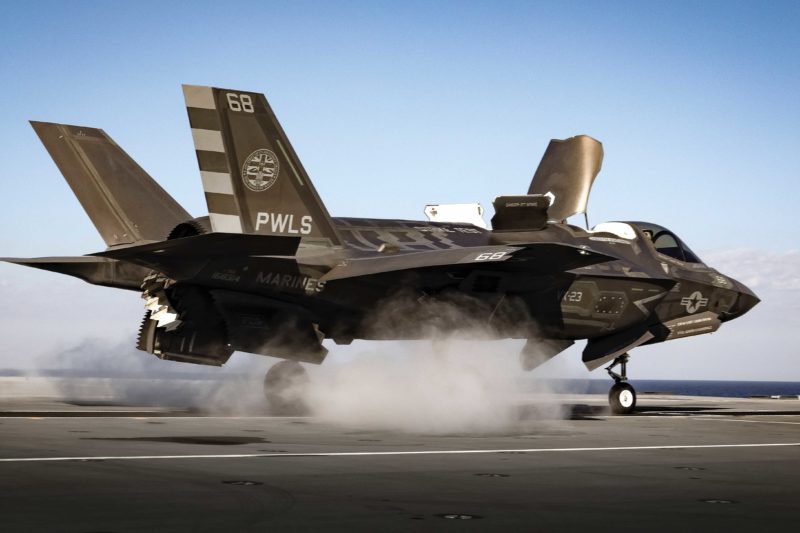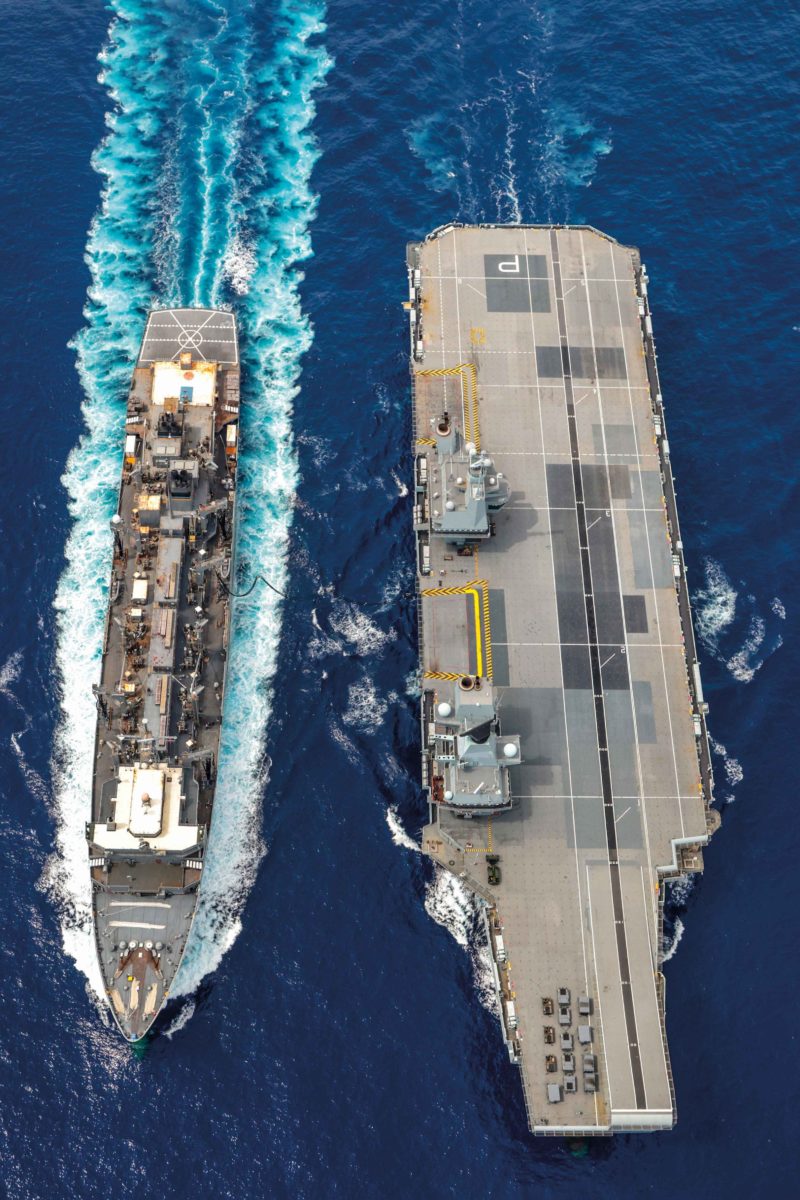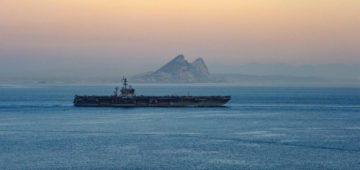
This autumn two naval vessels met at sea off the eastern seaboard of the USA, with one (an American) providing fuel-on-the-move to the other (British) – the latest demonstration of navies with a close working relationship putting things into practice. It was a spectacular moment in the Western Atlantic deployment of HMS Prince of Wales, with the former conducting a Replenishment -at- Sea (RAS) with the latter (USNS Supply) while the US Navy guided-missile destroyer USS Oscar Austin rode shotgun in the background. More than 80 years earlier the previous HMS Prince of Wales was the embodiment of the burgeoning close working partnership of the two navies. That battleship carried Prime Minister Winston Churchill to Placentia Bay, Newfoundland, for a meeting with President Franklin D. Roosevelt, in order to sign the Atlantic Charter, which established a joint global vision between Britain and the USA.
Last month another signing took place, aboard the carrier HMS Prince of Wales, when the boss of the Royal Navy, Admiral Sir Ben Key, hosted Admiral Lisa Franchetti, the US Navy’s Vice Chief of Naval Operations, and General Eric Smith, Commandant of the US Marine Corps. They signed an updated ‘strategic charter’, otherwise known as ‘Delivering Combined Seapower’ (DCS), which according to the USN ‘includes a shared vision to enable the next level of interoperability the joint force requires, acceleration of US-UK interchangeability, and underscores the collective dedication to safeguarding global maritime interests and promoting a rules-based international order.’
That the UK’s new Queen Elizabeth Class carriers are a platform for taking naval co-operation between two nations to new heights was made clear when the Queen Elizabeth deployed in 2021 to Indo-Pacific with a squadron of US Marine Corps (USMC) F-35B jets embarked alongside those of the joint RN-RAF Lightning Force.

Admiral Franchetti, who at the time of the DCS signing was the nominee to become the Chief of Naval Operations (CNO), explained during the summit aboard HMS Prince of Wales: “Delivering is the key word here.” She went on: “The US and UK are providing real, operationally relevant capabilities that are making a difference on the oceans every single day. This document reflects the significant progress we’ve made since the original charter nine years ago and clearly articulates how we will advance and expand our interchangeability and deliver combined seapower going forward.” Admiral Key, who is also the First Sea Lord, explained that the DCS “is testament to the enduring strength of the relationship between our navies and marines. By aligning our strategies and capabilities, we strengthen our ability to deter threats, respond to crises, and promote stability across the world’s oceans. This partnership will undoubtedly enhance our collective effectiveness, create opportunities to work ever more closely together, and promote our shared values.”
Although the US Marine Corps had previously taken part in US-UK DCS strategic dialogues, the 2023 revision marked the first time the USMC has been formally incorporated into the charter. “I’m proud to be in this endeavour with Admiral Franchetti and Admiral Key,” said General Smith. “Both countries’ marines and sailors have long-enjoyed a unique bond. We need to continue moving toward full interoperability, which includes maximizing our information sharing, training on each other’s platforms, and finding novel ways to integrate at the staff and warfighter level. This charter is a real step forward toward that goal.” During her current Westlant deployment HMS Prince of Wales is aiming to push the limits of aircraft carrier operations with drones, UK and USMC fifth-generation stealth fighters (F-35B Lightning II jets), plus US Marine Corps tilt-rotors and helicopters.

The deployment has seen advanced take-off and landing techniques tested, allowing
F-35Bs to return to the carrier faster and heavier (with more fuel and weapons aboard).
That cuts the time between sorties, allowing the ship to launch more strike missions and faster. HMS Prince of Wales will be looking to launch and land the F-35Bs in the heaviest sea states, proving that they can operate in the harshest conditions.
HMS Prince of Wales has even been hosting junior US Navy warfare officers to give them an insight into Britain’s biggest warship. Officers from destroyers USS Donald Cook and USS Winston S. Churchill (named after the Anglo-American WW2 British P.M.) joined the carrier for a recent voyage from Mayport to Norfolk. The USN officers integrated fully in the ship’s routines and were particularly impressed by the UK carrier’s tech, not least the massive vessel’s high degree of automation. Before heading home for Christmas, Prince of Wales is also due to experiment with landing and take-offs by the next-generation of Short Take- Off and Landing (STOL) drones currently under development.
The US-made Mojave drone can carry a 1,500lb payload of missiles, rockets or bombs and has been specifically designed to land on and take-off from short runways, or carrier flight-decks.
BACK in WW2 when the previous Prince of Wales visited the same waters, the primary weapon for a capital ship of the British surface fleet was big guns, in her case the 14-inch.
Today’s Prince of Wales is pushing the envelope of projecting firepower hundreds of miles via means that would have been unimaginable in the 1940s. It is thanks to the enduring naval Special Relationship at sea.


-
Report partly based on material provided by the USN and RN.



Comments
Sorry, comments are closed for this item